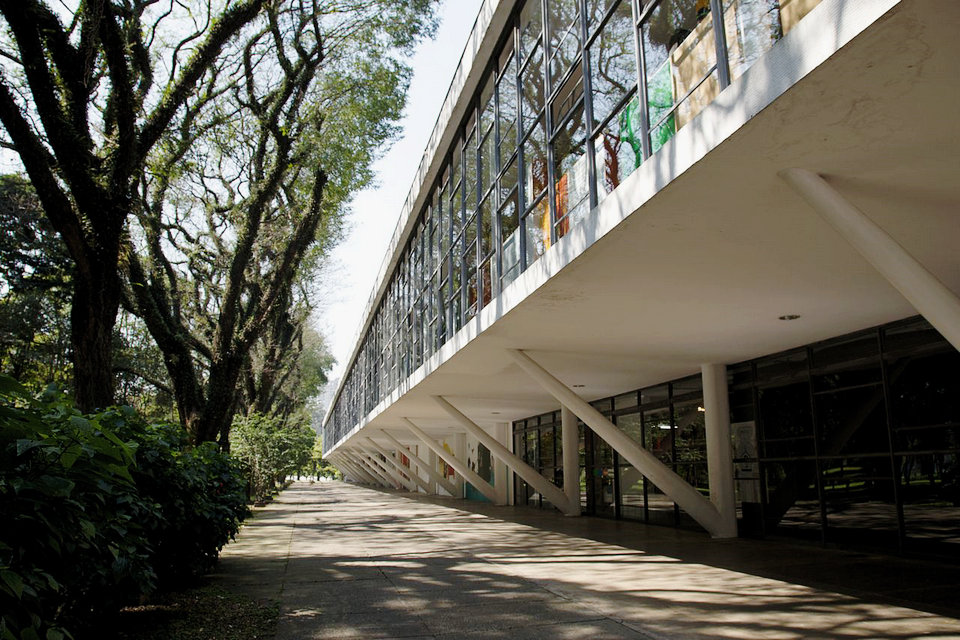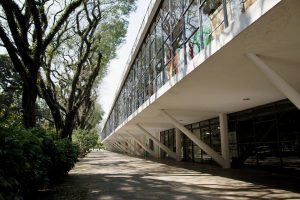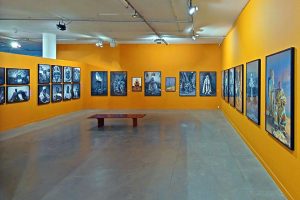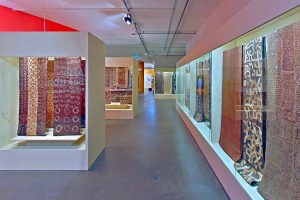The Afro Brasil Museum is a historical, artistic and ethnological museum, dedicated to research, conservation and exhibition of objects related to the cultural universe of blacks in Brazil. It is located in Ibirapuera Park, in São Paulo, in the “Padre Manuel da Nóbrega Pavilion” – building belonging to the park’s architectural complex designed in the 1950s by architect Oscar Niemeyer, with structural projects by engineer Joaquim Cardozo. Inaugurated in 2004, the Afro Brasil Museum is a public institution, subordinated to the State Secretariat of Culture and managed by a civil society organization.
Afro Brasil Museum is a 11.000 m2 building designed by the renowned Brazilian architect Oscar Niemeyer. It is inside the most important urban park in São Paulo, Ibirapuera Park. Over than 6,000 works highlight the importance of African people in the formation of Brazilian culture, heritage and identity as known nowadays. Also, it offers a celebration of the art and accomplishments of the Africans and Afro-Brazilians.
It conserves a collection of approximately 6 thousand works, including paintings, sculptures, engravings, photographs, documents and ethnological pieces, by Brazilian and foreign authors, produced between the 15th century and today. The collection encompasses several facets of the African and Afro-Brazilian cultural universes, addressing themes such as religion, work, art, the African diaspora and slavery, and recording the historical trajectory and African influences in the construction ofBrazilian society. The museum also offers a variety of cultural and educational activities, temporary exhibitions, a theater and a specialized library.
Overview
Museu Afro Brasil is a public institution, held by São Paulo State Secretariat for Culture and managed by Associação Museu Afro Brasil – Organização Social de Cultura (Museu Afro-Brasil Association – Social Organization for Culture). It aims to be a contemporary museum where the black people can be recognized.
Over than 6,000 works highlight the importance of African people in the formation of Brazilian culture, heritage and identity as known nowadays. Also, it offers a celebration of the art and accomplishments of the Africans and Afro-Brazilians.
The Collection is considered the largest Afro – American in American with more than 6,000 masterpieces, sculptures, documents, engravings, ceramics, paintings, contemporary arts, jewelry, objects, reliefs, photographs and textiles.
Over than 70% of the collection is in the long term exhibition, portraying mainly Brazil, some countries from the African Continent, Cuba, Haiti and the United States.
History
The Afro Brasil Museum was born on the initiative of Emanoel Araújo, a Bahian visual artist, former curator of the Pinacoteca of the State of São Paulo and current curator of the museum. Over two decades, Emanoel Araújo carried out a series of research, publications and exhibitions related to the historical, cultural and artistic heritage of black people in Brazil. From the 1990s, the plastic artist organized important exhibitions on the theme, in several cities in Brazil and in some European countries, culminating in two mega-exhibitions: Negro de Corpo e Alma, presented during the “Mostra do Redescobrimento”, in2000, and Brazil: Body and Soul, at the Guggenheim Museum in New York, in 2001. During that time, Emanoel Araújo also collected a valuable private collection, with more than 5,000 works referring to the Afro-Brazilian cultural universe.
In 2004, Araújo – who had already tried frustratingly to make possible the creation of an institution focused on the study of African contributions to national culture – presented the museological proposal to the then mayor of São Paulo, Marta Suplicy. The idea was taken over by the municipal government, the project to implement the museum began. Resources from Petrobras sponsorship and the Ministry of Culture (Rouanet Law) were used. The management of the museological project was the responsibility of the Florestan Fernandes Institute. To form the initial collection, Emanoel Araújo donated 1100 pieces from his private collection on loan. It was decided that the museum would be installed in the Padre Manoel da Nóbrega Pavilion. The building, belonging to the prefecture, was on loan to the State Government since 1992 and housed for a time an extension of the State Pinacoteca. In 2004, he returned to the municipal administration and underwent adaptations to receive the museum. On October 23 of that same year, the Afro Brasil Museum was inaugurated, in the presence of President Luís Inácio Lula da Silva and other authorities.
The Afro Brasil Museum proposes to address the contribution of black men in Brazil through three strands: memory, history and art. The institution’s objective is to use its ethnographic, historical and artistic collection to support the creation of a center for reflections on Afro-Brazilian culture, which also involves its immaterial consequencesand the need to preserve historical consciousness. Aiming at educating the public, the museum maintains an eclectic cultural agenda, offers lectures and courses and several temporary exhibitions related to the theme of Afro-Brazilian cultural production and the recovery of the memory of the black universe. The museum has managed to considerably expand its collection, through acquisitions, donations and loans from private collectors and other institutions. In 2005, the museum inaugurated the “Carolina Carolina de Jesus Library”. Formed from the private collection of Emanoel Araújo, the collection of the library was recently masterfully expanded through the donation of the Escravidão – Trafficking – Abolition Library, the most important and rare collection of titles on the theme existing in the country, offered to the institution by Ruy Sousa e Silva and Leonardo Kossoy.
The Padre Manoel da Nóbrega Pavilion
The Padre Manoel da Nóbrega Pavilion, originally called Palácio das Nações, is one of the buildings forming part of the Ibirapuera Park architectural complex, designed by architect Oscar Niemeyer with structural calculations by engineer Joaquim Cardozo. The project, commissioned by Ciccillo Matarazzo, aiming at the official celebrations of the IV Centenary of the City of São Paulo, intended to transform the new city park into an irradiating center of art and culture. In addition to the Palace of Nations, the Palace of States (headquarters of PRODAM), the Palace of Industries (Bienal Pavilion), the Palace of Exhibitions (Oca), the Palace of Agriculture (headquarters of DETRAN) and the auditorium (recently built). The ensemble is listed by the National Historical and Artistic Heritage Institute.
The Palace of Nations was opened in December 1953. That same year, it shares with the Palácio das Indústrias the function of the headquarters of the historic II International Biennial of São Paulo, housing part of the 3,374 works exhibited in this edition, among which are 74 paintings by Pablo Picasso, including the famous Guernica. The two pavilions also hosted the 3rd edition of the Bienal, in 1955. Between 1961 and 1991, the building, already renamed “Pavilhão Padre Manoel da Nóbrega”, housed the city of São Paulo. With the transfer of the municipal executive to the Palácio das Indústrias, the building was transferred to the State Government in 1992, and started to be used as an extension of the Pinacoteca do Estado. In 2004, the pavilion returned to the municipal administration, becoming the headquarters of the Afro Brasil Museum.
The building has 11 thousand square meters of built area, divided into three floors. In addition to the exhibition spaces, didactic areas, technical reserve and administrative offices, it houses the Carolina Maria de Jesus Library and the Ruth de Sousa Theater.
Collection
The Afro Brasil Museum Collection preserves more than 5,000 works that encompass different areas from multiple African, indigenous and Afro-Brazilian cultural universes. Divided through thematic groups, the collection seeks to cover aspects of art, Afro-Brazilian religion, popular Catholicism, work, slavery, popular festivals, thus recording the historical, artistic trajectory and the important African influences in the construction of Brazilian society.
Its collection consists of prints, paintings, drawings, watercolors, sculptures, historical documents, photographs, furniture, textile works, feather, basketwork, ceramics, among other works elaborated since the century. XVI to the present day. But the objective of making the Afro Brasil Museum collection available online is not limited to the works themselves, we also aim to progressively make public the most relevant research data about the works to researchers, teachers, students, visitors and interested parties in general. of this collection.
Consisting of more than 300 works, the core of traditional African art at the Afro Brasil Museum encompasses works by dozens of peoples that make up the main examples of this art present in museums. As it could not be otherwise, special attention is given to people whose Atlantic links with Brazil in close ties are historically recognized. Among these, we have works by the peoples: Yoruba, Fon, Bini, Baule, Iaure, Senufo, Attie, Bamana, Dogon, Landuma, Bijagó, Chokwe, Baluba, Bakongo, Suku, Makonde, among others.
Africa
The core of the collection dedicated to the history, culture and art of Africa preserves a large number of objects, of the most diverse aesthetic concepts and functionalities, produced, mainly, by ethnic groups of the sub-Saharan nations, between the 15th and 20th centuries. There are works for ritual, magic or religious use (representations of gods and other divine entities, maternal figures linked to fertility rituals, figurines invested with medicinal power, etc.) and artifacts for everyday use (procession pipes, combs, reliquaries and elements furniture).
The materials used (wood, ivory, terracotta, fabrics, beads etc.) vary according to the source. Various cultural groups and countries are represented: Attie (Côte d’Ivoire), Bamileque (Cameroon), Yombe, Luba (Democratic Republic of Congo), Yoruba (Nigeria), among many others. The rich collection of African masks stands out, composed of pieces of admirable aesthetic sense and imbued with different symbologies, used in ancient cults and rites and as instruments of control and regulation of social order in numerous ethnic groups (Yoruba,ecóis, Bobo, Gueledé, etc.).
The nucleus also includes a series of works produced by European artists, covering important aspects of African historiography. There are Dutch maps from the 17th century, reproducing the African territory, ethnological lithographs produced by Rugendas, engravings and photographs depicting powerful figures from the African kingdoms of the past.
Work and slavery
This nucleus deals with the role of enslaved Africans and their descendants in the construction of Brazilian society, as a fundamental workforce in all the country’s economic development cycles. It retains iconographic documents that attest to both the brutality of this process and the gradual and silent assimilation by society of African values and customs arising from the diaspora. There are several lithographs by Debret and Rugendas, recording the punishments applied to slaves by their masters, the trips in the holds of slave ships and the forced labor in sugar mills.
The nucleus conserves several tools of carpentry, carpentry and other work instruments used by slaves, in addition to a series of instruments of torture and punishment, such as throats, paddles and turn-worlds. The nucleus also includes a series of photographs, by authors such as Marc Ferrez, Victor Frond and Virgílio Calegari, registering black slaves and freedmen in their trades.
Another important collection of this nucleus is made up of documents related to the African resistance to slavery and the participation of blacks in the Brazilian independence movements. There are quilombo maps from the 18th century, advertisements for rewards for capturing runaway slaves, artistic representations of black resistance leaders and personalities linked to the abolitionist movement, such as Zumbi dos Palmares and José do Patrocínio, performed by artists such as Alípio Dutra and Antônio Parreiras.
Sacred and profane
In this nucleus, works related to the imposition of the Christian faith on black captives are preserved, largely documenting the subsequent religious syncretism that marks Brazilian society. Catholic festive celebrations – seen in the colonial period as major civic events and important instruments for the spread of Christian doctrine – provided social spaces for African slaves and their descendants to appropriate these festivities, often adapting Catholic symbolism to their cultural references. and rites of origin.
A large number of prints, watercolors and photographs stand out in the collection, documenting both religious parties of popular Catholicism and Afro-Brazilian confraternities (parties of Nossa Senhora do Rosário, Divino and the Irmandade da Boa Morte) as well as ” folkloric ” celebrations. of black influence (congadas, maracatu, bumba-meu-boi, coronation of the black kings, etc.), in addition to the adornments, masks, objects and clothes used in these festivities. The cult of black saints, such as Santo Elesbão, Santa Ifigênia and São Benedito, is represented through an imaginary selection from the colonial period. Also important is the large collection of ex-votos – imaginary imbued with votive intentions, whether magical or religious, widely produced in Colonial Brazil.
Afro-Brazilian religiosity
In addition to the appropriation and reinterpretation of elements present in Catholic festivities, slavery forced contact and coexistence between religions of different African peoples, resulting in a multiple assimilation of similar elements from their cultures. In this way, deities, rites and cults of different origins were merged into a common amalgam, which resulted in Afro-Brazilian religions. In this nucleus, pieces related to these religions, their characters and rites are preserved, ranging from sculptures and photographs to clothing and altars, dating from the colonial period to the present day.
Noteworthy are the various pieces related to Quimbanda, Xangô and, mainly, Candomblé – a religion of Yoruba origin, widespread throughout the Brazilian territory – such as statuettes of Iemanjá, Ibejis and ritual objects of orixás, produced in Brazil and in Africa, in its most diverse aspects (Kekes, Jejes, Angola, etc.). There are several specimens of balangandãs, jewels and amulets used by Bahian women on festive and ritual occasions. There is also an important set of photographs by artists such asPierre Verger, Mário Cravo Neto, Maureen Bisilliat and Adenor Gondim, documenting Afro-Brazilian religious rites.
History and memory
In the nucleus dedicated to history and memory, the greatest concern is to rescue and remember the great black and mulatto exponents that stood out in several areas, from the colonial period to the present day. Thus, paintings, photographs, sculptures, engravings and documents related to historical personalities (Zumbi dos Palmares, Henrique Dias, José do Patrocínio), writers and journalists (Luís Gama, Antônio Gonçalves Crespo, Cruz e Sousa, Machado de Assis) are preserved, engineers (André Rebouças, Teodoro Sampaio), doctors (Juliano Moreira), artists (Ruth de Souza) and intellectuals in general (Milton Santos, Manuel Querino etc.).
The nucleus is also composed of material testimonies of the historical evolution of blacks in Brazil. There are objects and documents that report the involvement of blacks in historical episodes such as the Battle of the Guararapes, the Levante dos Malês, the Paraguayan War, the Chibata Revolt and the 1932 Revolution. There is a vast iconography about the 19th century abolitionist movement, as well as a significant sample of essays and periodicals produced by the black press in Brazil in the 19th and 20th centuries (collections of newspapers such as A Liberdade, A Voz da Raça and O Clarim d’Alvorada, among others).
Arts
This nucleus preserves important examples of the black presence throughout the evolution of the arts in Brazil. It mainly preserves works of art executed by black and mulatto artists, but also includes pieces that have the black universe as their theme. It is noticeable and well documented the strong presence of black artists during the colonial period, which would end up defining Brazilian art in a definitive way. In the museum’s inventory of gems, sculptures by Aleijadinho and Mestre Valentim, and paintings by José Teófilo de Jesus, Frei Jesuíno do Monte Carmelo, Veríssimo de Freitas and Joaquim José da Natividade are preserved.
With the institution of official education by the Imperial Academy of Fine Arts (closely associated with the formation of the country’s economic elite), the black contribution to national art significantly diminished. Even so, important examples of this current are preserved, represented in the collection by the still lifes of Estêvão Silva, in the portraits made by Antônio Rafael Pinto Bandeira and Emmanuel Zamor, in the landscapes by Antônio Firmino Monteiro and in the vast set of paintings executed by the João brothers and Artur Timóteo da Costa (self-portraits and portraits of blacks, navies, landscapes and studies of nudes, among others).
In the segment referring to 20th century art, there is a set of paintings by Benedito José Tobias, several serigraphs and sculptures by Rubem Valentim, and other works by Heitor dos Prazeres, Ronaldo Rêgo, Octávio Araújo, Manuel Messias, Joseph Pace, Caetano Dias, José Igino, Tibério, Jorge Luís dos Anjos, among others. Finally, there are representative sets of Afro-Brazilian popular art, where the works of Mestre Didi stand out, and a collection of artistic photographs, by names such asMadalena Schwartz, André Vilaron, Eustáquio Neves, Sergio Valle Duarte, Walter Firmo, Alfred Weidinger among others.
Events
The Afro Brasil Museum for events has the Ruth de Souza Theater, an auditorium that receives Brazilian and international artists and promotes meetings with intellectuals and politicians. For the 2014 Brazil Soccer World Cup and as part of the celebrations of the 10th anniversary of the Afro Brasil Museum (2004-2014), the museum organizes the exhibition “O Negro no Futebol Brasileiro, A arte os artisas (Tribute to Mário Filho)” that celebrates Afro-descendent players like Pelé, Garrincha, Didi, Djalma Santos, Barbosa, Zizinho et Jairzinho in the history of football in Brazil and its importance in the construction of the Brazilian national identity. Among the portraits and caricatures of the players, part of the exhibition are the works of football themes created for the event, which are now part of the permanent collection of the museum, such as the thematic installation “Stadium” of the Beninese artist Aston, the “Football Votive Masks” based on the Geledés rituals carried out by the Beninese artist Kifouli, the rotating jewelry sculpture “Mundial Brasileiro” by the Italian artistJoseph Pace and the work “Diamante Negro – Inventor da Bicicleta” (2014), an acrylic spray on canvas by one of the main names of graffiti in Brazil, the Brazilian artist Speto.








